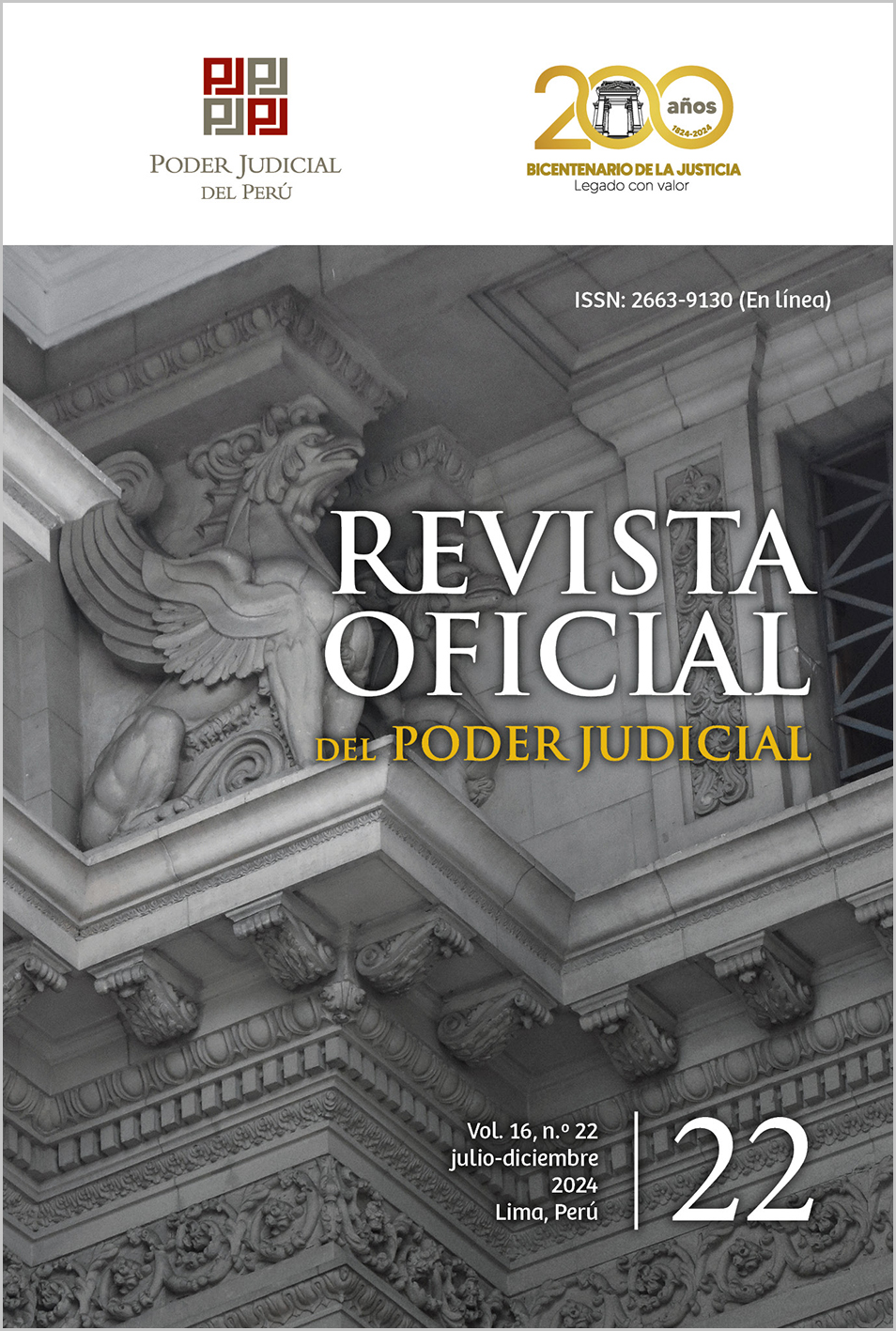The Criminal Procedural Program in 19th-century Constitutions: A brief historical review of jury trials in Peru
Abstract
The criminal process is built upon the Constitution. Its legal regulation is not independent but arises inevitably from the fundamental norm of the State. It is precisely within this instrument that the general framework of principles is established, from which the specific rules governing the criminal process in a nation are derived. This theoretical core is referred to in Hispanic-American doctrine as the Procedural Criminal Program of the Constitution, and in Portuguese doctrine as the Procedural Criminal Constitution. It emerged in the 1980s, coinciding with the paradigm shift brought by the Spanish Constitution of 1978, and was later debated in Peru with the 1993 Constitution. In this context, it is logical that there are no research studies aimed at analyzing the historical procedural criminal program in national constitutions. Thus, this manuscript seeks to explore part of the procedural criminal program that developed during the 19th century in Peru, with a particular focus on the institution of trial by jury, a topic rarely addressed by national doctrine due to its ineffective implementation during that period. This text does not aim to provide an exhaustive analysis but rather an introduction to the concepts of the procedural criminal program of the Constitution and trial by jury, intended to promote their investigation and historical analysis.
Downloads
Metrics
Métricas alternativas
References
Altuve-Febres, F. (1999). La Ley Constitucional de 1856. En Temas de Derecho. Homenaje a José León Barandiarán (t. I, pp. 343-362). Fondo Editorial del Congreso del Perú.
Altuve-Febres, F. (2001a). La Constitución de 1867. Revista Abogados, (6), 104-110.
Altuve-Febres, F. (2001b). La Constitución de 1834. https://altuve.pe/files/La-Constituci%C3%B3n-de-1834.pdf
Altuve-Febres, F. (2009). La Constitución de 1828. En J. Avendaño, C. A. Soto, A. Bullard, R. Ortiz, C. Ramos, M. Rubio y L. Zolezzi (eds.), Homenaje a Fernando de Trazegnies Granda (t. I, pp. 207-222). Fondo Editorial de la Pontificia Universidad Católica del Perú.
Arrieta, J. (2017). Apogeo y declive del derecho constitucional a un juicio por jurado para causas penales en los Estados Unidos. Derecho PUCP, (78), 129-169. https://doi.org/10.18800/derechopucp.201701.006
Barreiros, J. A. (1988). La nueva constitución procesal penal. Revista de Estudios Políticos (Nueva Época), (60-61), 719-738.
Basadre, J. (1995). El Perú de 1839 y la Constitución de Huancayo. Ius et Veritas, 6(11), 9-14. https://revistas.pucp.edu.pe/index.php/iusetveritas/article/view/15504
Baumann, J. (1986). Derecho procesal penal. Conceptos fundamentales y principios procesales: introducción sobre la base de casos. Ediciones Depalma.
Dunbar, E. (2019). La institución del jurado. Centro de Estudios Constitucionales.
Espinosa, C. (2010). Teoría de la motivación de las resoluciones judiciales y jurisprudencia de casación y electoral. Tribunal Contencioso Electoral.
Lasalle, F. (2005). ¿Qué es una Constitución? Ariel Derecho.
Lorca, A. (2017). La constitucionalización del proceso. Vox Iuris, 34(2), 125-132.
Maier, J. (2017). Derecho procesal penal (t. I). Editores del Puerto. Manzanares, J. L. (1976). La caución penal. Anuario de Derecho Penal y Ciencias Penales, 29(2), 262-292.
Martínez, F. (2011). Constitución de la Justicia en Cádiz. Jurisdicción y consultas en el proceso constituyente de la potestad judicial. Anuario de Historia de Derecho Español, (81), 377-408.
Maurach, R. (1948). Tratado de derecho penal. Editorial A. T.
Meini, I. (2013). La pena: función y presupuestos. Derecho PUCP, (71), 141-167. https://doi.org/10.18800/derechopucp.201302.006
Mir, S. (2003). Introducción a las bases del derecho penal. BdeF.
Morón, J. C. (2000). Bolívar y su propuesta constitucional de 1826. Derecho PUCP, (53), 173-243. https://doi.org/10.18800/derechopucp.200001.005
Paniagua, V. (2003). La Constitución de 1828 y su proyección en el constitucionalismo peruano. Historia Constitucional, (4), 103-150.
Pareja, J. (1943). La Constitución de 1823. Revista de la Universidad Católica, (1), 15-29. https://repositorio.pucp.edu.pe/index/handle/123456789/53457
Pareja, J. (1981). Derecho constitucional peruano y la Constitución de 1979. Pontificia Universidad Católica del Perú.
Ramos, C. (2017). El jurado de imprenta y dos casos en Arequipa. Iuris Omnes. Revista de la Corte de Justicia Superior de Arequipa, 19(2), 13-36.
Rodríguez, M. P. (2006). La constitucionalización del proceso penal: principios y modelo del Código Procesal Penal 2004 (NCPP). Foro Jurídico, (06), 73-94. https://revistas.pucp.edu.pe/index.php/forojuridico/article/view/18431
Sota, A. (2013). Programa Penal de la Constitución Política de 1993 y el derecho penal constitucional peruano. Derecho y Cambio Social, 10(31), 1-20.
Villarán, M. (1962). La Constitución peruana comentada. Universidad Nacional Mayor de San Marcos.
Zagrebelsky, G. (2011). El derecho dúctil. Ley, derechos, justicia. Trotta. Zagrebelsky, G., Marcenò, V. y Pallante, F. (2020). Manual de derecho constitucional. Zela Editores.
Fuentes normativas y jurisprudenciales
Expedientes n.os 52-2003/56-2003/57-2003 (2004). Corte Suprema de Justicia de El Salvador (1 de abril de 2004).
Copyright (c) 2024 Diego Alonso Noronha Val

This work is licensed under a Creative Commons Attribution 4.0 International License.
The authors retain their copyrights and register under the Creative Commons Attribution 4.0 International License (CC BY 4.0), which allows the use of the published material (adapt - remix, transform and build - and share - copy and redistribute - the material in any medium or format).
1. The journal allows authors to retain their copyrights of submitted articles without any restrictions.
2. Authors retain the right to share, distribute, copy, perform and publicly communicate the article published in Revista Oficial del Poder Judicial (e.g., place it in an institutional repository).
3. Authors retain the right to make a subsequent publication of their work, to use the article or any part of it (for example: a compilation of their work, notes for conferences, thesis, or for a book), as long as they indicate the source of publication (authors of the work, journal, volume, number and date).






















